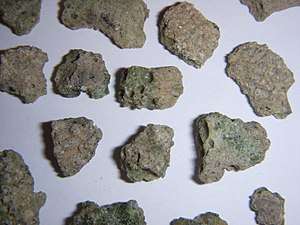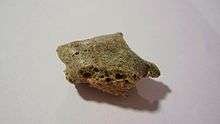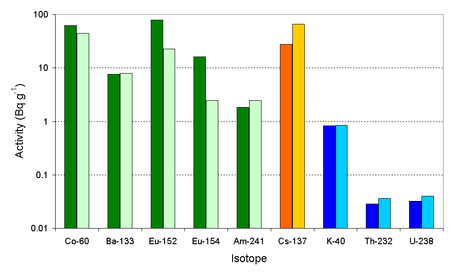Trinitite
Trinitite, also known as atomsite or Alamogordo glass,[2] is the glassy residue left on the desert floor after the plutonium-based Trinity nuclear bomb test on July 16, 1945, near Alamogordo, New Mexico. The glass is primarily composed of arkosic sand composed of quartz grains and feldspar (both microcline and smaller amount of plagioclase with small amount of calcite, hornblende and augite in a matrix of sandy clay)[3] that was melted by the atomic blast. It is usually a light green, although color can vary. It is mildly radioactive but safe to handle.[4][5][6]




In the late 1940s and early 1950s, samples were gathered and sold to mineral collectors as a novelty. Traces of the material may still be found at the Trinity site as of 2019, although most of it was bulldozed and buried by the United States Atomic Energy Commission in 1953.[7] It is now illegal to take the remaining material from the site; however, material that was taken prior to this prohibition is still in the hands of collectors.
Formation
In 2005 it was theorized by Los Alamos National Laboratory scientist Robert Hermes and independent investigator William Strickfaden that much of the mineral was formed by sand which was drawn up inside the fireball itself and then rained down in a liquid form.[8] In a 2010 article in Geology Today, Nelson Eby of University of Massachusetts at Lowell and Robert Hermes described trinitite:
Contained within the glass are melted bits of the first atomic bomb and the support structures and various radionuclides formed during the detonation. The glass itself is marvelously complex at the tens to hundreds of micrometre scale, and besides glasses of varying composition also contains unmelted quartz grains. Air transport of the melted material led to the formation of spheres and dumbbell shaped glass particles. Similar glasses are formed during all ground level nuclear detonations and contain forensic information that can be used to identify the atomic device.[9]
This evidence has been supported by F. Belloni et al. in a 2011 study based on nuclear imaging and spectrometric techniques.[10]
The glass has been described as "a layer 1 to 2 centimeters thick, with the upper surface marked by a very thin sprinkling of dust which fell upon it while it was still molten. At the bottom is a thicker film of partially fused material, which grades into the soil from which it was derived. The color of the glass is a pale bottle green, and the material is extremely vesicular with the size of the bubbles ranging to nearly the full thickness of the specimen."[3]
An estimated 4.3 × 1019 ergs or 4.3 × 1012 joules of heat energy went into forming the glass and as the temperature required to melt the sand into the glass form observed was about 1470 Celsius, this was the estimated minimum temperature the sand was exposed to.[11]
One of the more unusual isotopes found in trinitite, although by no means unique as it may also have formed during the Joe-1 test, which was a partial to complete Soviet replica of the Trinity/Fat Man design, is a barium neutron activation product, the barium in the Trinity device coming from the slow explosive lens employed in the device, known as Baratol.[12]
Fake trinitite
There are many known fakes in circulation among collectors.[13] These fakes use a variety of means to achieve the glassy green silica look as well as mild radioactivity; however, only trinitite from a nuclear explosion will contain certain neutron activation products that are not found in naturally radioactive ores and minerals. Gamma spectroscopy can narrow down the potential nuclear explosions from which the material formed.
Anthropogenic trinitite-type minerals
Occasionally, the name trinitite is broadly applied to all glassy residues of nuclear bomb testing, not just the Trinity test.[14]
Black vitreous fragments of fused sand that had been solidified by the heat of the explosion were described from French test site in Algeria (Reggane site).[15]
Kharitonchik
Kharitonchiki (singular: kharitonchik, Russian: харитончик) is an analog of trinitite found in Semipalatinsk Test Site in Kazakhstan at ground zeroes of Soviet atmospheric nuclear tests. Also generically called Kharitonchik. They are pieces of molten rock left at ground zeroes after Soviet atmospheric nuclear tests. This porous black material is named after one of the leading Russian nuclear weapons scientists, Yulii Borisovich Khariton.[16]
Naturally occurring trinitite-like minerals
Trinitite has several similar naturally occurring minerals as it is itself a melt glass.[17]
Fulgurites
While trinitite and similar materials are anthropogenic, fulgurites, found in many thunderstorm-prone regions and in deserts, are naturally-formed, hollow or solid glassy tubes, masses, droplets, clumps, or crusts composed of quartzose sand, silica, rock, caliche, biomass, clay or other soil and sediment types, and are generated by lightning strikes.
Impact glasses
Impact glass, a material similar to trinitite, can be formed by meteor impacts.[18]
Jewelry use
For a time it was believed that the desert sand had simply melted from the direct radiant thermal energy of the fireball and was not particularly dangerous. Thus, it was marketed as suitable for use in jewelry in 1945.[19][20]
References
- P. P. Parekh, T. M. Semkow, M. A. Torres, D. K. Haines, J. M. Cooper, P. M. Rosenberg and M.E. Kitto (2006). "Radioactivity in Trinitite six decades later". Journal of Environmental Radioactivity. 85 (1): 103–120. CiteSeerX 10.1.1.494.5179. doi:10.1016/j.jenvrad.2005.01.017. PMID 16102878.CS1 maint: multiple names: authors list (link)
- Giaimo, Cara (June 30, 2017). "The Long, Weird Half-Life of Trinitite". Atlas Obscura. Retrieved July 8, 2017.
- Optical properties of glass from Alamogordo, New Mexico
- Kolb, W. M., and Carlock, P. G. Trinitite, 1999, The Atomic Age Mineral. This does not link to the book. http://www.orau.org/ptp/collection/hiroshimatrinity/trinitite.htm
- Nuclear weapons question, Bad Astronomy and Universe Today Forum. May not be entirely accurate. http://www.bautforum.com/general-science/9499-nuclear-weapons-question.html
- Analyzing Trinitite, Hunter Scott. http://www.hscott.net/analyzing-trinitite-a-radioactive-piece-of-nuclear-history/
- Carroll L. Tyler, AEC letter to the Governor of New Mexico, July 16, 1953. Nuclear Testing Archive, NV0103562: https://www.osti.gov/opennet/detail?osti-id=16166107
- Robert Hermes and William Strickfaden, 2005, "New Theory on the Formation of Trinitite", Nuclear Weapons Journal "Archived copy". Archived from the original on 2008-07-26. Retrieved 2014-03-17.CS1 maint: archived copy as title (link)
- Eby, N., Hermes, R., Charnley N., Smoliga J. (24 September 2010). "Trinitite—the atomic rock". Geology Today. 26 (5): 180–185. doi:10.1111/j.1365-2451.2010.00767.x.CS1 maint: multiple names: authors list (link)
- Belloni, F.; Himbert, J.; Marzocchi, O.; Romanello, V. (2011). "Investigating incorporation and distribution of radionuclides in trinitite". Journal of Environmental Radioactivity. 102 (9): 852–862. doi:10.1016/j.jenvrad.2011.05.003. PMID 21636184.
- "INTERIM REPORT OF CDC'S LAHDRA PROJECT – Appendix N. pg 38" (PDF). Archived from the original (PDF) on 2014-03-17.
- Parekh, P. P.; Semkow, T. M.; Torres, M. A.; et al. (2006). "Radioactivity in trinitite six decades later". J Environ Radioact. 85: 103–20. CiteSeerX 10.1.1.494.5179. doi:10.1016/j.jenvrad.2005.01.017. PMID 16102878.
- "Real or faux?". www.lanl.gov. Retrieved 2019-12-20.
- Robert Twigger (2010). "Eight". Lost Oasis: In Search Of Paradise. Hachette. ISBN 9780297863878. Retrieved 2014-03-18.
- Radiological Conditions at the Former French Nuclear Test Sites in Algeria: Preliminary Assessment and Recommendations International Atomic Energy Agency, 2005
- "A Nuclear Family Vacation in Russia." Slate. July 10, 2006.
- Wittke JH, Weaver JC, Bunch TE, Kennett JP, Kennett DJ, Moore AM, Hillman GC, Tankersley KB, Goodyear AC, Moore CR, Daniel IR Jr, Ray JH, Lopinot NH, Ferraro D, Israde-Alcántara I, Bischoff JL, DeCarli PS, Hermes RE, Kloosterman JB, Revay Z, Howard GA, Kimbel DR, Kletetschka G, Nabelek L, Lipo CP, Sakai S, West A, Firestone RB (2013). "Evidence for deposition of 10 million tonnes of impact spherules across four continents 12,800 y ago". Proceedings of the National Academy of Sciences of the United States of America. 110 (23): E2088–97. doi:10.1073/pnas.1301760110. PMC 3677428. PMID 23690611.
- "Wine Bottle Art – Ingenious Methods to Recycle Wine Bottles". Colloidal silicon dioxide. 16 October 2010.
- Steven L. Kay – Nuclearon – Trinitite varieties
- "INTERIM REPORT OF CDC'S LAHDRA PROJECT – Appendix N. pg 39, 40" (PDF). Archived from the original (PDF) on 2014-03-17.
Further reading
External links
| Wikimedia Commons has media related to Trinitite. |
| Look up trinitite in Wiktionary, the free dictionary. |